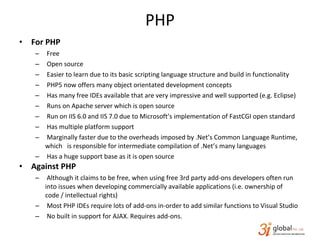3iGlobal Pvt. Ltd. - Presentation on Web 2.0 Technologies
- 1. PRESENTATION ON WEB 2.0
- 2. What is the Web? The World Wide Web, abbreviated as WWW and commonly known as the Web, is a system of interlinked hypertext documents accessed via the Internet. Web or Web 1.0 (1991-2003) refers to the state of the World Wide Web, and any website design style used before the advent of the Web 2.0 phenomenon. Web 1.0 began with the release of the WWW to the public in 1991. The general term that has been created to describe the Web before the "bursting of the Dot-com bubble" in 2001.
- 3. Web History Web 1.0 1991 – 2003 Static Pages Read Only 2004 - Present Dynamic Pages Read /Write Web 2.0 Web 3.0 2010 – Future Intelligent Data- driven Personalization (ads, iGoogle) Natural language search WEB 2.0 2010 2000 2005 1995 1990 Web 1.0 web 3.0
- 4. Evolution of the Web
- 5. Ěý
- 6. Podcasts Blogs Photo Management Satellite Maps Video Wikis ePortfolios Social Bookmarks Online Groups Social Networks Voice Thread Scrapbooks Virtual Worlds Project Sharing Types of Web 2.0 Technology
- 7. Why Web 2.0 ? Web 2.0 works as a customizable network system to link users to information and each other. Web 2.0 is not just a technological revolution, but also a social revolution! Ease of use and short learning curve. The power of Me!! Simplicity!!
- 8. Requirements and Pre-requisites Drive to learn new technology. Basic Programming knowledge (Optional).
- 9. Tools Used HTML / CSS PHP / JSP / ASP.NET / PERL MYSQL / MS-SQL / ORACLE / DB2 Javascript / JQUERY / prototype AJAX Wordpress / Joomla / WEB CMS
- 10. Vs .
- 11. PHP For PHP Free Open source Easier to learn due to its basic scripting language structure and build in functionality PHP5 now offers many object orientated development concepts Has many free IDEs available that are very impressive and well supported (e.g. Eclipse) Runs on Apache server which is open source Run on IIS 6.0 and IIS 7.0 due to Microsoft’s implementation of FastCGI open standard Has multiple platform support Marginally faster due to the overheads imposed by .Net’s Common Language Runtime, which is responsible for intermediate compilation of .Net’s many languages Has a huge support base as it is open source Against PHP Although it claims to be free, when using free 3rd party add-ons developers often run into issues when developing commercially available applications (i.e. ownership of code / intellectual rights) Most PHP IDEs require lots of add-ons in-order to add similar functions to Visual Studio No built in support for AJAX. Requires add-ons.
- 12. ASP.NET For ASP.Net Can be developed using the stunning Visual Studio.Net IDE that offers vast array of features, that make coding much easier and development more productive Developers can download a free scaled down version of Visual Studio that offers an impressive array of features. This is aimed at students and hobbyists Runs on IIS (Internet Information Services) Applications can be written using many programming languages (e.g VB.Net, C#, J#, C++ COBAL) The .Net framework (the engine that ASP.Net is runs on) has more sophisticated error handling capabilities than PHP Allows better separation of design and application logic using of code-behind pages and user-controls Has built support for AJAX as of .Net Framework 3.5 Against ASP.Net Requires a Microsoft licenses Requires a basic knowledge of object orientated concepts which can sometimes deter newbie developers
- 13. THANK YOU AND LETS K.I.S.S. (Keep It Simple Stupid)













